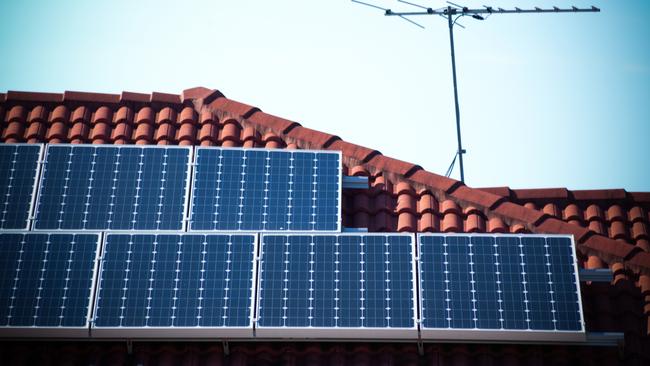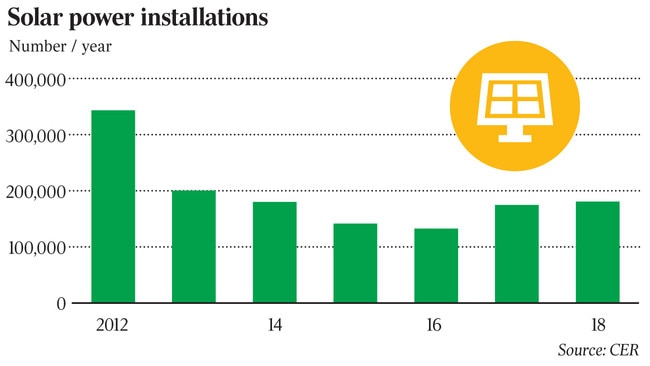Warning as solar ‘failed in grid crisis’
The operator of Australia’s electricity grid has raised the prospect of household rooftop solar panels being retrofitted.

The operator of Australia’s electricity grid has raised the prospect of household rooftop solar panels being retrofitted to ensure they meet compliance standards after some units failed to adequately respond to a major interconnector outage last year, which isolated two states from the power system.
An official investigation found thousands of rooftop solar units did not comply with Australian standards after a lightning strike caused the Queensland and South Australian interconnectors to trip simultaneously on August 25, forcing electricity to be cut to big industrial users and retail customers in NSW and Victoria.
A range of supply sources including solar, wind and coal generators either crashed or were unable to assist in boosting supply to either of the two states, renewing concerns over the challenges of integrating a surge of cheap but intermittent renewable energy supply within the national grid to complement existing baseload generation.
The Australian Energy Market Operator detailed how 15 per cent of sampled solar systems installed before October 2016 dropped out during the emergency event. Of those installed after that date, nearly a third in South Australia and 15 per cent in Queensland failed to meet the Australian standard for reducing excess frequency.

Changes to compliance and accreditation processes may be needed, according to AEMO, as it investigates why the solar inverters — which convert electricity from rooftop panels into power that can be fed to the grid — failed to respond as expected. This could even involve retro-fitting some solar devices to ensure they meet standards, a move that could come at a high price.
“We are at a point of saturation in certain parts of the network that there may be certain pockets that do need to be looked at again but it wouldn’t be on a large scale,” AEMO’s executive general manager for operations Damien Sanford told The Australian.
“We are world-leading for the size of our grid in terms of the volume of residential solar and we don’t want to slow that development down, but we want to make sure that what’s going in is supportive of the grid’s needs.” AEMO says standards and management of the nation’s booming rooftop solar market must improve as part of a broader review of the rules and regulations governing the grid to reflect greater slabs of renewable energy in the national electricity market. More than two million solar panel units have now been installed in homes across Australia, with capacity growing at 50 per cent a year.
The market operator aims to complete an assessment of the technical requirements of solar inverters by June and improve their performance standards by the end of 2019. It also hopes to obtain better data and develop simulation models and analysis by the end of 2020 to predict the response of solar rooftop to “system disturbances” like last year’s major outage.
AEMO’s recommendations follow a warning from Energy Minister Angus Taylor last month to his state counterparts that lives could be at risk from unsafe or sub-standard solar panel installations, with a national audit report finding up to one-quarter of all rooftop units inspected posed a severe or high risk due to faulty wiring and unsecured panels.
AEMO conceded the varying quality springing from the rapid growth of solar installation firms might partly be to blame for the performance of the units in last year’s outage.
Some 4100 registered solar companies in Australia are expected to generate $1.4 billion in revenue this financial year with demand for qualified installers ballooning to meet the 20 per cent year-on-year growth in uptake of the units.
“That sort of growth comes with its training challenges and just the frantic pace of work given that growth,” Mr Sanford said. “So there is the potential for incorrect installations to have occurred, which may have contributed to these issues.”
Variations in settings on the solar inverters may have also contributed to the muted response from solar.
“There are settings that need to be applied for voltage and frequency management and some of those settings are to protect the grid and also to protect the equipment itself. They may not have been correctly applied. There may also have been localised network conditions on the day that caused those systems to trip off,” Mr Sanford said.
The government remained focused on reliability and reducing power prices, acting energy minister Matt Canavan told The Australian in response to AEMO’s investigation.
“The rapid investment in intermittent generation, including rooftop solar, requires a focus on reliability of our electricity supply,” he said. “The reliability obligation, agreed to at December’s COAG Energy Council meeting, will require retailers to invest in enough generation to meet customer needs well ahead of time.”
State and territory governments have responsibility for installation compliance, while solar subsidies are administered by the federal government under the small-scale renewable energy scheme, part of the renewable energy target.




To join the conversation, please log in. Don't have an account? Register
Join the conversation, you are commenting as Logout